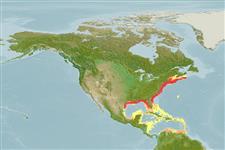Actinopterygii (ray-finned fishes) >
Scorpaeniformes (Scorpionfishes and flatheads) >
Triglidae (Searobins) > Prionotinae
Etymology: Prionotus: Greek, prion, -onos = saw + Greek, noton = back (Ref. 45335).
Environment / Climate / Range
Ecology
Marine; brackish; demersal; depth range 15 - 170 m. Temperate, preferred ?; 46°N - 10°N, 98°W - 60°W
Western Atlantic: Nova Scotia in Canada to central Florida in USA. Gulf of Mexico (Ref. 26938).
Size / Weight / Age
Maturity: Lm ? range ? - ? cm
Max length : 38.0 cm TL male/unsexed; (Ref. 7251); common length : 30.0 cm TL male/unsexed; (Ref. 3822)
Occurs on sandy bottom. Feeds on shrimps, crabs, other crustaceans, squid, bivalves and small fishes. Produces loud, drumming sound by vibrating its swim bladder (Ref. 9988). Used both for food and fish meal; other uses include bait for lobster traps and flatfish, handlines, pet food and fertilizer. Utilized fresh and frozen; also used for caviar ; can be broiled and baked (Ref. 9988).
Life cycle and mating behavior
Maturity | Reproduction | Spawning | Eggs | Fecundity | Larvae
Robins, C.R. and G.C. Ray, 1986. A field guide to Atlantic coast fishes of North America. Houghton Mifflin Company, Boston, U.S.A. 354 p. (Ref. 7251)
IUCN Red List Status (Ref. 115185)
CITES (Ref. 94142)
Not Evaluated
Threat to humans
Harmless
Human uses
Fisheries: minor commercial; bait: occasionally
More information
Age/SizeGrowthLength-weightLength-lengthLength-frequenciesMorphometricsMorphologyLarvaeLarval dynamicsRecruitmentAbundance
Tools
Special reports
Download XML
Internet sources
